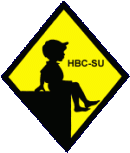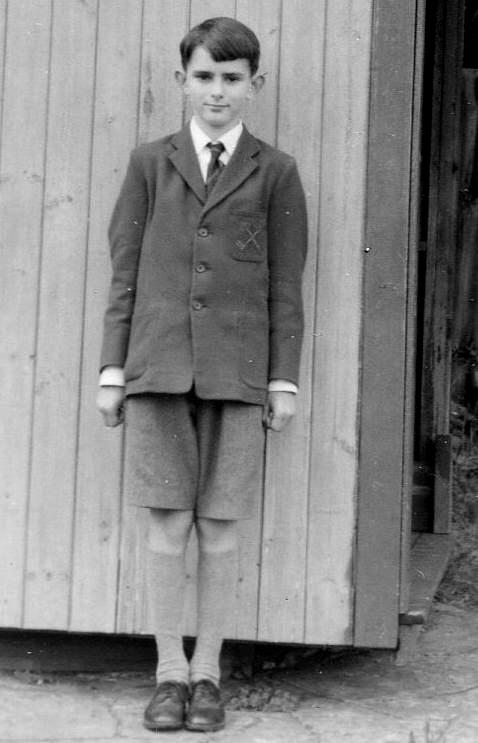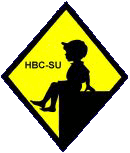
English School Uniforms: Day Preparatory School Clothes (1956-62)

Figure 1.--This is me, in summer 1962, in the prep school uniform+. This was one of two photographs that my parents took of me as official mugshots for the grammar school. Note how long the shorts are - these are the ones that caused me some grief later on. I've no idea why the left leg looks longer than the right! We finished painting that side of the summer house the following year, as I recall.
|
|
My school life began at a boys-only (private-sector) prep (sc. preparatory) school. Such schools are different to American prep schools in that they are for younger children. This school was fairly typical of smaller British prep schools in that we were all day pupils, aged from 5 to 13. Pre-preps today often have different uniforms or varied uniforms from the prep schools to which they are attached. At our school as there no separate pre-prep section, the uniform was the same for all the children. Our uniform was a plain grey suit (winter) or grey trousers with purple blazer (summer term only). Shorts were the norm, reaching to a little above the knee - one or two of the boys in the top form (13 years old) wore long trousers. For PT (as it was known there) indoors we changed into white plimsolls and removed our blazers and ties. In the summer we would normally be outside, for which we changed into white shirts (either button-up or t-shirts) and shorts, and wore plimsolls without socks. While in principle a prep school prepares pupils for the Common Entrance examination at age 13, which would permit entry to Public Schools (i.e. private-sector senior schools), in practice about a third of the pupils took the Eleven-Plus exam and then went, as I did, to one of the local Grammar Schools (i.e. academically selective public-sector secondary schools). The reason my parents chose to send me to the prep school was the much smaller classes – typically 20 rather than the 30 - 40 in public-sector primary schools. The class size at the Grammar School was 25 – 30, which, with older children, was not seen as a problem.
British Prep Schools
These schools are different than American prep schools in that they are for younger children. They were traditional boarding schools preparing boys for the public (private secondary) schools or other senior schools. The standard prep school was for boys 8-13 years old. Some accepted day boys and there were day prep schools. While the standard British prep school was a boarding school, but there were also day schools in most towns. Boarding schools were much more expensive. Thus day schools provide many of the advantages of a private school at a price modest-income families could afford. My parents thought that the small class sizes were worth paying for. With hindsight, I suspect that a mixed gender prep school would have been better for me than all boys, but as I don't think there was one in the area, I suspect this wasn't an option.
My School
My school was fairly typical of smaller British prep day schools. we were all day pupils, aged from 5 to 13. While in principle a prep school prepares pupils for the Common Entrance examination at age 13, which would permit entry to Public Schools (i.e. private-sector senior schools), in practice about a third of the pupils took the 11-Plus exam and then went, as I did, to one of the local Grammar Schools (i.e. academically selective public-sector secondary schools). The reason my parents chose to send me to the prep school was the much smaller classes – typically 20 rather than the 30-40 in public-sector primary schools. The class size at the Grammar School was 25–30, which, with older children, was not seen as a problem.
Prep School Uniform
Pre-preps today often have different uniforms or varied uniforms from the prep schools to which they are attached. At our school as there no separate pre-prep section, the uniform was the same for all the children. Our uniform was a plain grey suit (winter) or grey trousers with purple blazer (summer term only). Shorts were the norm, reaching to a little above the knee - one or two of the boys in the top form (13 years old) wore long trousers, but this was rare and only permitted for the top form. A white shirt was worn with the school tie. In cold weather, I wore a pullover (I think grey) under the jacket. Socks were long and grey, under black lace-up shoes (outdoors) or brown sandals (indoors): we therefore had to change our shoes to play outside at break-times. In bad weather, a navy-blue gabardine raincoat was specified, optionally with a school scarf. A cap was worn to and from the school. Apart from the grey suit in the winter, this was all fairly typical of most such schools at the time.
For PT (as it was known there) indoors we changed into white plimsolls and removed our blazers and ties. In the summer we would normally be outside, for which we changed into white shirts (either button-up or t-shirts) and shorts, and wore plimsolls without socks. On (I think only) one occasion we were all told to strip to the waist, which I found very strange, but this was not normal practice. I don’t ever remember anyone doing PT barefoot. Games in the winter was football (soccer) for which we wore navy-blue shorts, football shirts in either white or the school colours, school football socks and boots. In the summer we played cricket, for which we wore much the same as for summer PT, but with white socks. Underpants were permitted, but not vests: the coloured football shirts were horribly scratchy on bare skin, so that I eventually persuaded my mother to line mine! The length of the PT shorts was quite variable, and latterly some boys wore them well above the knee, while others wore them little shorter than the gray shorts.
Regulations
I don’t remember anyone having to do PT or games without the specified kit, so I imagine that our mothers all checked up that we’d got what we were supposed to have. Kit was only brought to school for the days it was needed anyway. I remember that on one occasion a boy could not find his sandals (he’d been off sick for a few days and they’d been moved) so he spent the morning until break in his socks, without shoes. Nobody told him to do otherwise so I presume he had done what was expected of him. Fortunately he found the sandals at break-time.
Next School
There were several options as to the senior (secondary) school after prep schools. Most boys whose families were well off sent the boys on to the public schools which were private fee-paying schools. Boys from more modest income families, like me, if they were academically capable would attend grammar schools. These were secondary level day schools with strong academic programs.
Other Schools
It might be of interest to compare what we wore for PT with what boys at other primary and prep schools wore at about the same time (1950's). This is information picked up from friends and other sources. It's worth noting that virtually all boys in this age-group at the time wore shorts. For indoor PE, there were big differences between schools: at some, the boys did as we did, and just took off blazers, jumpers, ties and the like, and wore plimsolls with or without socks. Quite often, they would also be expected to strip to the waist. If the floor was suitable (ours wasn't), bare feet would often be required. Boys who wore long trousers would be expected to change into shorts, but otherwise ordinary school shorts were worn. Some schools required boys to strip to their underwear, usually to just underpants. Relatively few schools - mainly prep schools - had a proper PE kit, which would usually be just a pair of shorts, sometimes with plimsolls. Games would be either football (soccer) or, at some prep schools, rugby, and in both cases the kit was similar: boots, coloured socks, shorts (usually but not invariably either black or navy blue), and usually two shirts (one white, one coloured), as reversible shirts were rare in those days. For outdoor PE (as opposed to games), which would usually be on tarmac or grass, plimsolls were normal (but not universal), shirts would usually be worn only if it was cold, and stripping to underwear was uncommon.
David
Navigate the Boys' Historical Clothing School Uniform Pages
[Return to the Main David Page]
[Return to the Main English 1950s School Page]
[Return to the Main English Personal School Experience Page]
[Australia]
[England]
[France]
[Germany]
[Italy]
[Japan]
[New Zealand]
[Scotland]
[Singapore]
[South Africa]
[United States]
Created: 1:35 AM 10/2/2008
Last updated: 7:35 PM 10/15/2009



